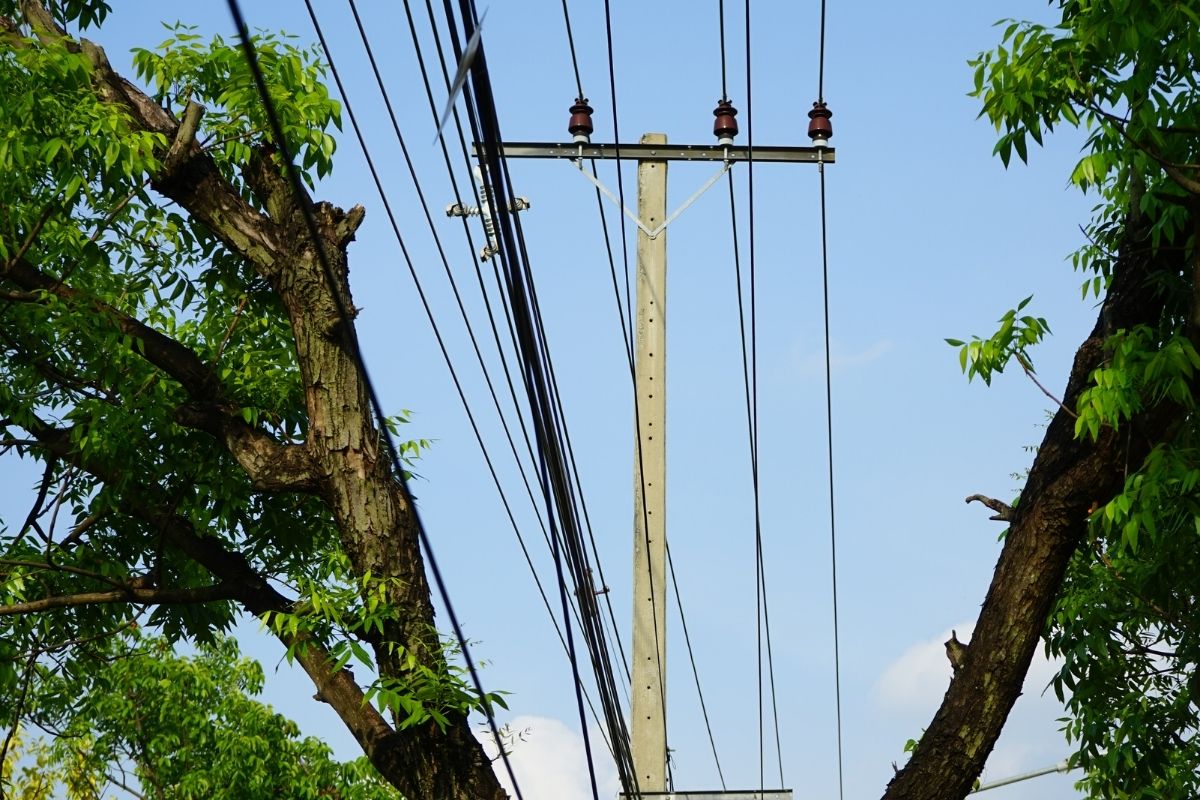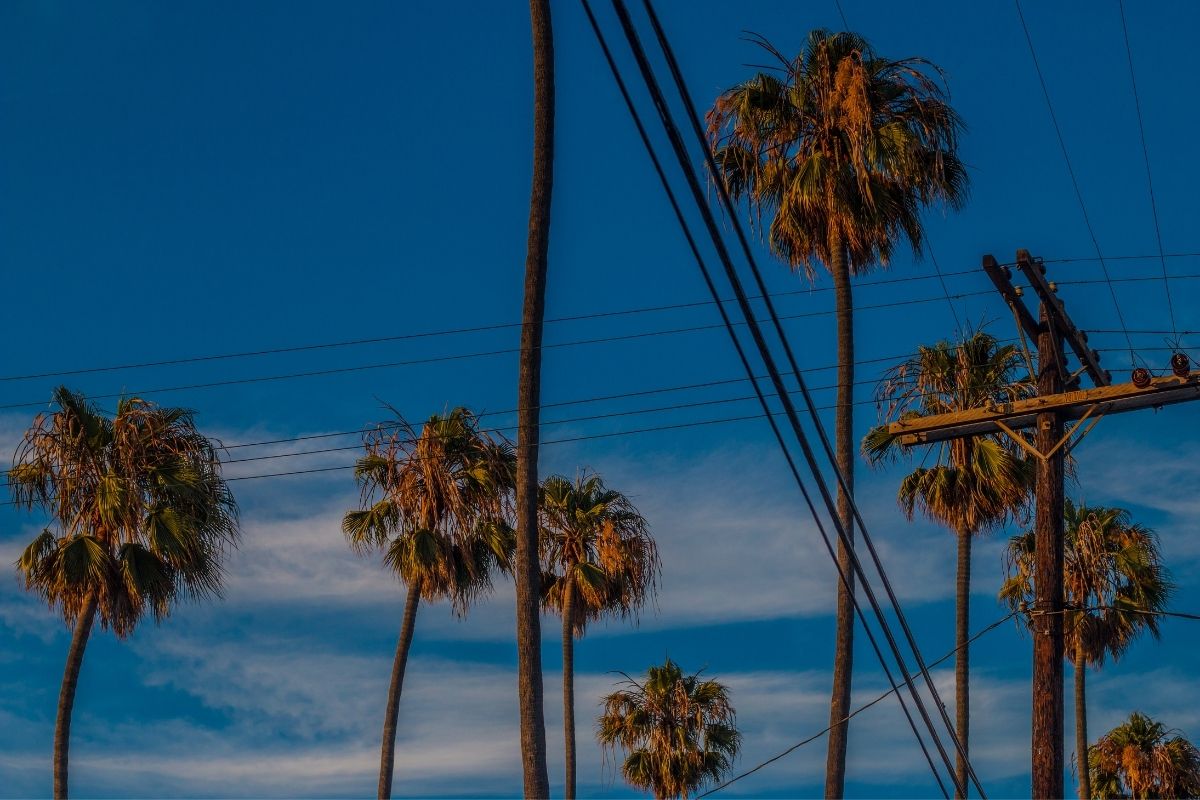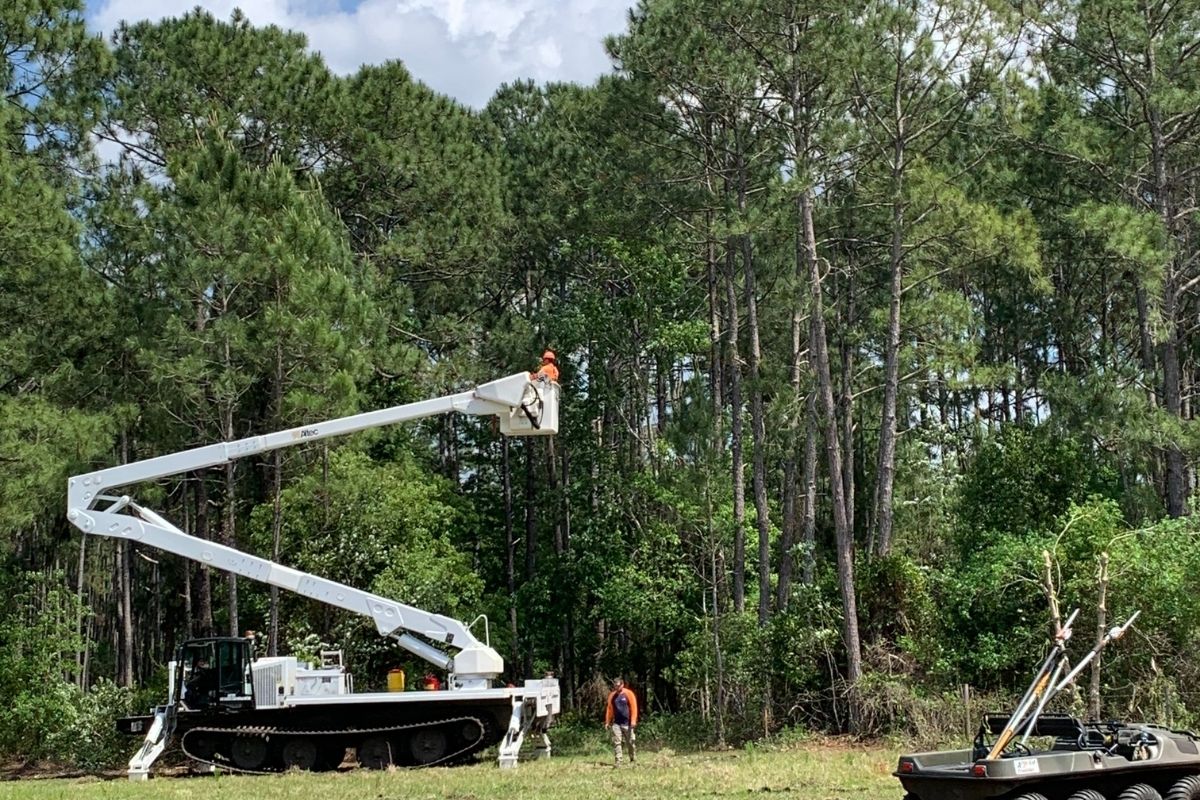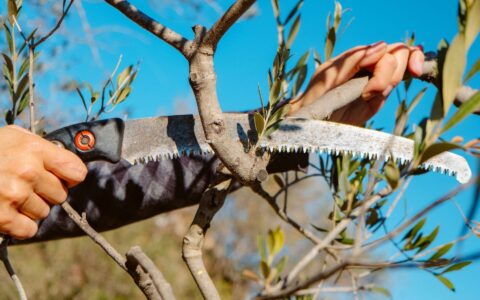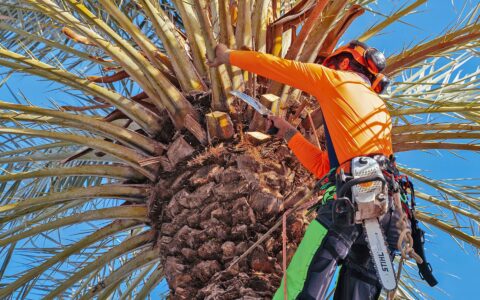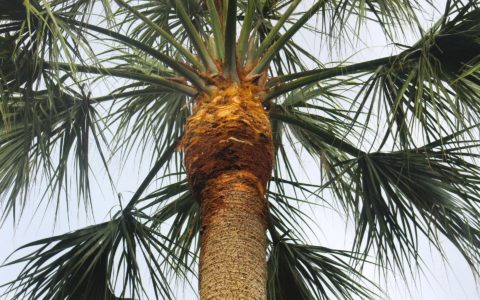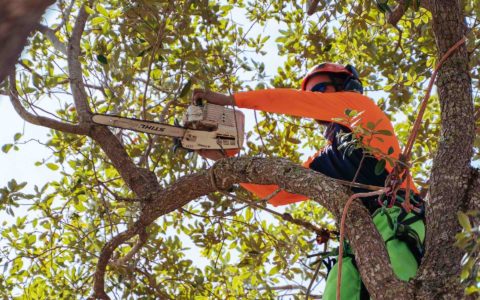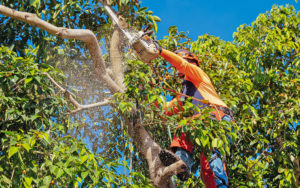One of the worst instances of the wrong tree being planted in the wrong place is when it comes to overhead utility lines. Many trees have had to undergo drastic pruning, or even removal, to make way for power lines. While it’s better for everyone involved to plant only smaller trees beneath power lines, that’s not always what happens. So, what can be done about trees growing into power lines, who does it, and why is it done the way it is?
FAQs About Trees & Power Lines
In this FAQs article, we answer common questions about pruning trees to “clear the line” (pruning trees away from power and utility lines). Keep reading to find out:
- why line clearing is done,
- what rules are in place when it comes to trees and power lines,
- how trees near power lines are pruned (hint: it’s not for aesthetics) and why trees are trimmed that way,
- what homeowners can do about trees on their own properties that are near utility lines,
- and much more!
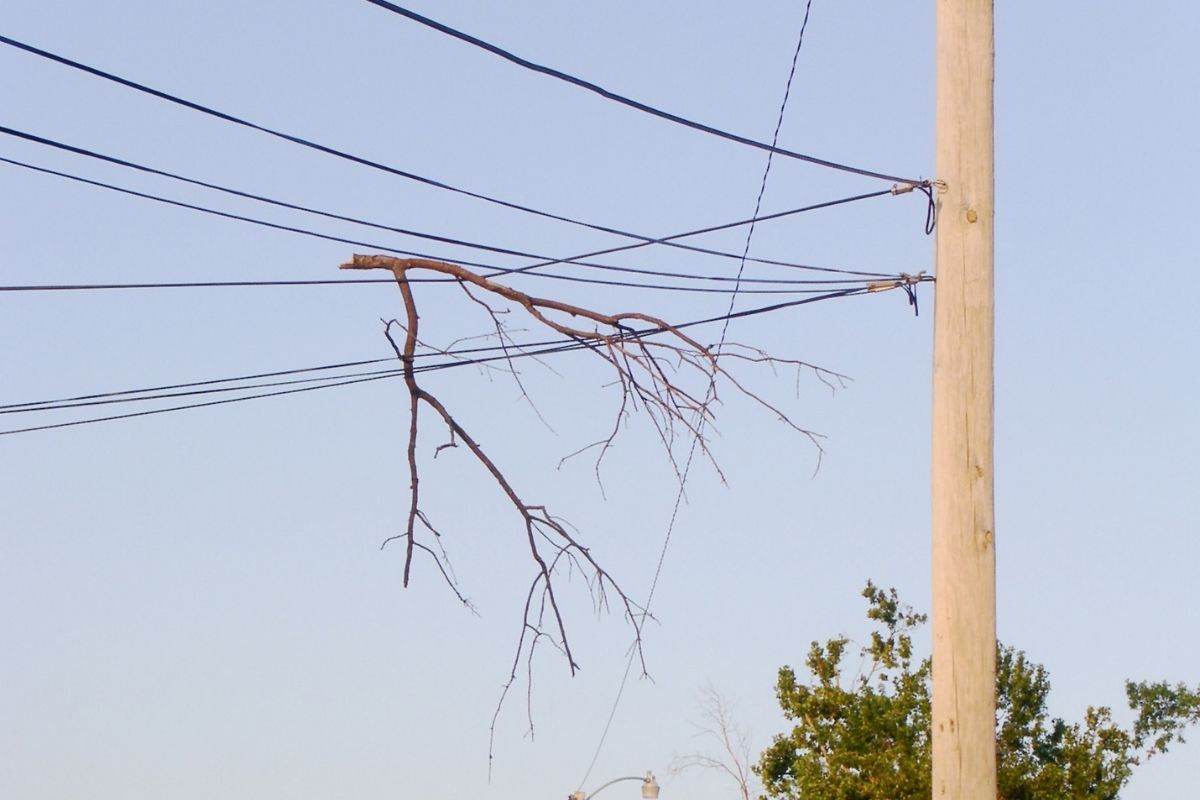
Why are trees pruned away from power lines?
Trimming trees to keep overhead utility lines clear is required for two reasons:
- To prevent power outages (depending on the location, an outage can affect thousands of people)
- To prevent damage to the lines from tree branches. Falling tree branches will pull down utility lines with them, and even branches brushing against lines in strong winds can be enough to cause an outage.
What’s the most common cause of power line damage and utility outages?
The main cause of power line damage is from trees. But you can’t blame the trees themselves. Trees are naturally flexible and bend in the wind. When a tree is growing into power lines, that flexibility means it can damage those lines as its branches move and sway.
When a tree is growing into power lines, it’s usually because someone chose a tree species without understanding how the tree’s mature size or growth habits might conflict with its surroundings.
We can’t “fix” existing trees that are too big, but we can help homeowners choose trees that are the right size for their planting areas!
What is line clearing?
Pruning tree branches away from around power lines is usually called line clearing. You may also hear other terms used, such as:
- Right-of-way (or ROW) clearing
- Incidental line clearing
- Power-line clearing
- Utility line clearing, and
- Brush and tree clearing.
No matter what name you use, this type of work has standards that are designed to keep utility infrastructure safe from conflicts.
How are trees trimmed around power lines?
Since overhead utility lines carry our electricity and communication lines, our daily lives rely on them. And it’s important to remember that pruning to prevent power line accidents or damage is almost always less expensive and disruptive than repairing damage after a tree has caused an outage.
So, while many people don’t like to see trees heavily pruned to keep lines clear, major tree pruning is required around utility lines.
Unfortunately, we can’t let trees grow in their natural form through the transmission lines because of how trees’ branching patterns develop. Instead, a specific type of tree pruning is used for this situation.
What is directional pruning?
“Directional pruning” is the tree trimming technique used on trees growing beneath power lines. Unlike residential or aesthetic pruning that enhances a tree’s natural form, directional pruning removes whole branches back to the main trunk.
This is done to direct the tree’s growth around the overhead lines. Usually, directional pruning results in a V-shaped tree. Where overhead lines and trees intersect, it’s the power line clearance requirements that dictate the tree’s shape.
How much of a tree is removed using directional pruning?
Each tree that’s pruned around power lines is evaluated individually. This is because there’s usually a mix of tree species planted under utility lines, and each species has its own growth habits.
Individual trees are also evaluated for their general health and their location relative to overhead lines. This helps to determine which branches will be pruned.
Trimming trees for utility line clearance also takes other important factors into consideration, such as:
- keeping areas clear for emergency-response vehicles, and
- clearing the right-of-way for updating and improving utility line connections.
Keeping areas clear for fast access is key when power outages from storms disrupt important public and commercial services.
Why are some trees removed during line clearing?
When tree pruning isn’t enough to prevent utility line conflicts, a tree (or other vegetation) may be removed. There are several important criteria used to decide if a tree should be removed.
- How fast a tree or shrub grows – In addition to its mature height, the rate at which a tree grows is important. Fast-growing trees and shrubs require frequent maintenance. If they grow too much between their scheduled pruning dates and conflict with overhead power lines, an outage can result.
- Overall tree health – When a tree under powerlines is in poor health from disease or is declining from age, it may be removed before it dies. This is because a tree that may have internal damage or structural problems can be unpredictable. A stressed tree is more likely to drop branches suddenly, and trees with hidden trunk or root damage can fall over even in clear weather. A tree in poor health that is a hazard should be removed before it falls.
The positive result of removing a failing tree is the chance to replant with a tree that is the right size for the location. Planting the right size tree reduces the chance of future line conflicts.
What rules relate to line clearing?
How trees are trimmed around power lines is regulated by ordinances and enforced standards. It’s not up to the individual arborist or tree service company to decide how the work should be done.
These rules ensure the right type and amount of line-clearing work is done, and that the professionals who are pruning trees are protected in potentially dangerous situations.
For example, common line clearing rules and guidelines include:
- Directional pruning guidelines are set by the American National Standards Institute (ANSI).
- ANSI A-300 pruning standards are endorsed by the International Society of Arboriculture (ISA).
- Safety rules and regulations for line clearance are outlined by the Occupational Safety and Health Administration (OSHA) in OSHA 1910.269.
- Electric transmission and distribution line right-of-way maintenance – Florida statute 163.3209
Can a utility company or line clearance contractor come on my property without permission?
If you have overhead utility lines running over your land, a utility company can access them if there’s a problem or maintenance need, even if that means going onto your property to do so. In other cases, utilities may have a specific right, granted by your deed, to use a corridor on your property—usually on a boundary line or near the property’s perimeter—to set up and maintain utility poles, lines, or towers.
Utility companies will generally try to notify you in advance if they’ll be on your land. However, they (and their approved contractors) can enter your property to access trees that need to be trimmed even if you aren’t home or haven’t received a notification.
Can homeowners prune or remove trees themselves?
Yes and no (mostly it’s no).
When trees and shrubs are small, or when they are not growing close to overhead lines or utility rights-of-way, homeowners can prune and maintain them.
Similar to residential pruning, a homeowner can prune branches that they can reach from the ground that are well away from power lines.
Once trees reach overhead lines, only trained professionals should prune them.
What if my tree is growing into power lines?
Florida Power and Light (FPL) works on their power lines based on an annual schedule. But a homeowner can make a vegetation request if a tree is conflicting with overhead lines.
SAFETY NOTE: If you see a tree that’s touching power lines, call 1-800-4OUTAGE
If Sherlock Tree Company is doing line clearance work on my trees, can I request that they work on my other trees, too?
No. When a crew from Sherlock Tree Company is working for Florida Power and Light, another utility company, or a municipality, they can only prune the trees identified for pruning in their work order.
If you have trees on your property that need pruning, contact Sherlock to schedule an appointment.
Are there South Florida trees that should not be planted near power or utility lines?
This is a partial list of trees that are known to cause conflicts with overhead lines:
- Australian pine, Casuarina equisitafolia
- Melaleuca, Melaleuca quinquenervia
- Brazilian pepper, Schinus terebinthifolius
- Tree bamboo, Bambusa vulgaris
- Schefflera, Brassaia actinophylla
- Ficus, non-native Ficus species
What trees are recommended to plant near power lines?
Small-scale trees that you can safely plant beneath overhead lines include:
- Silver Buttonwood, Conocarpus erectus var. sericeus
- Geiger Tree, Cordia sebestena
- Spanish Stopper, Eugenia foetida
- Florida Thatch Palm, Thrinax radiata
- Glaucous Cassia, Senna surattensis
FPL has more information about trees and power lines in South Florida, and a guide to which trees to use or avoid.
DID YOU KNOW? Sherlock Tree Company is one of the trusted companies that handle line clearing in South Florida.
Does Sherlock Tree Company do utility line clearing?
Sherlock is an approved contractor to prune trees for line clearing for:
- ATT
- Comcast, and
- Florida Power and Light.
Sherlock Tree Company is also a member of professional associations that provide ongoing education, training, and advocacy for arborists who perform utility line clearing, such as:
- The Utility Arborist Association
- The Society of Municipal Arborists
Before you plant a tree that might conflict with overhead lines, give us a call. We can help you choose the right tree, and we can plant your tree for you, too!
Call Sherlock for quality tree services
Whether you're looking for specific tree care services, such as palm trimming, tree removal, or disease treatments, or would like one of our Arborists to examine your trees to identify any issues and recommend options, we're always here for you! Just give us a call at 954-788-4000 to set up an appointment.
SEE MORE ARTICLES
Looking for more?
We've got you covered with a monthly newsletter full of tips, resources, updates, how-to's, and other helpful information about trees and landscapes in South Florida!

